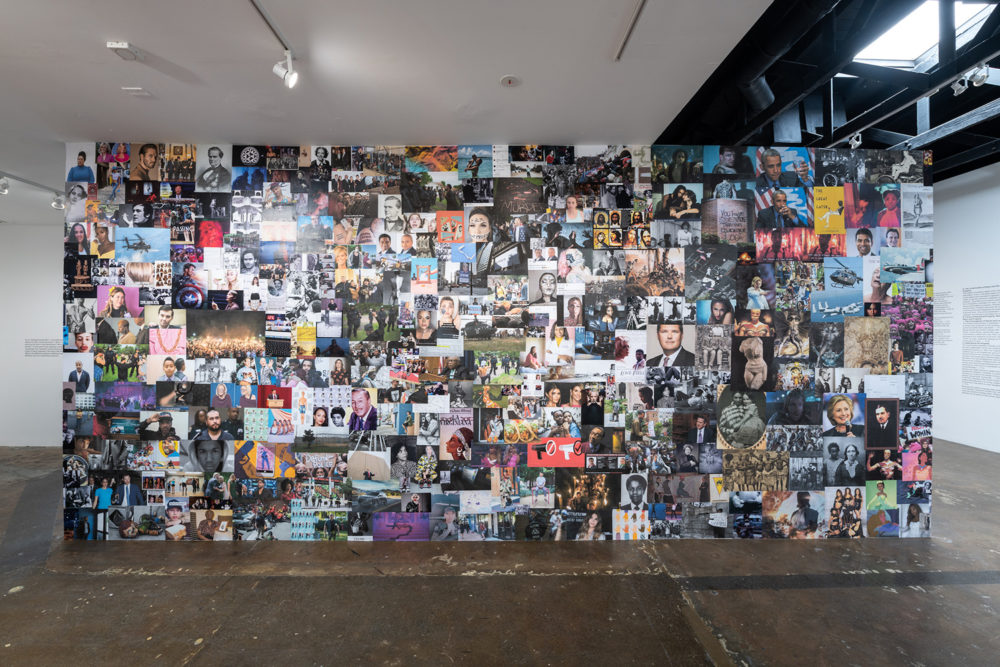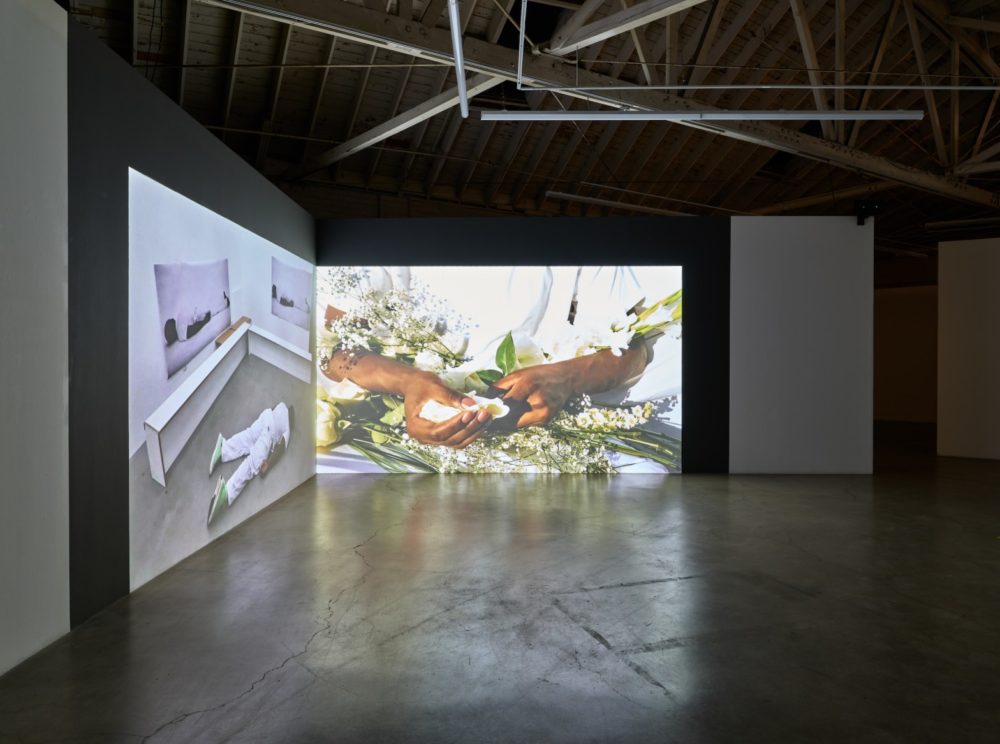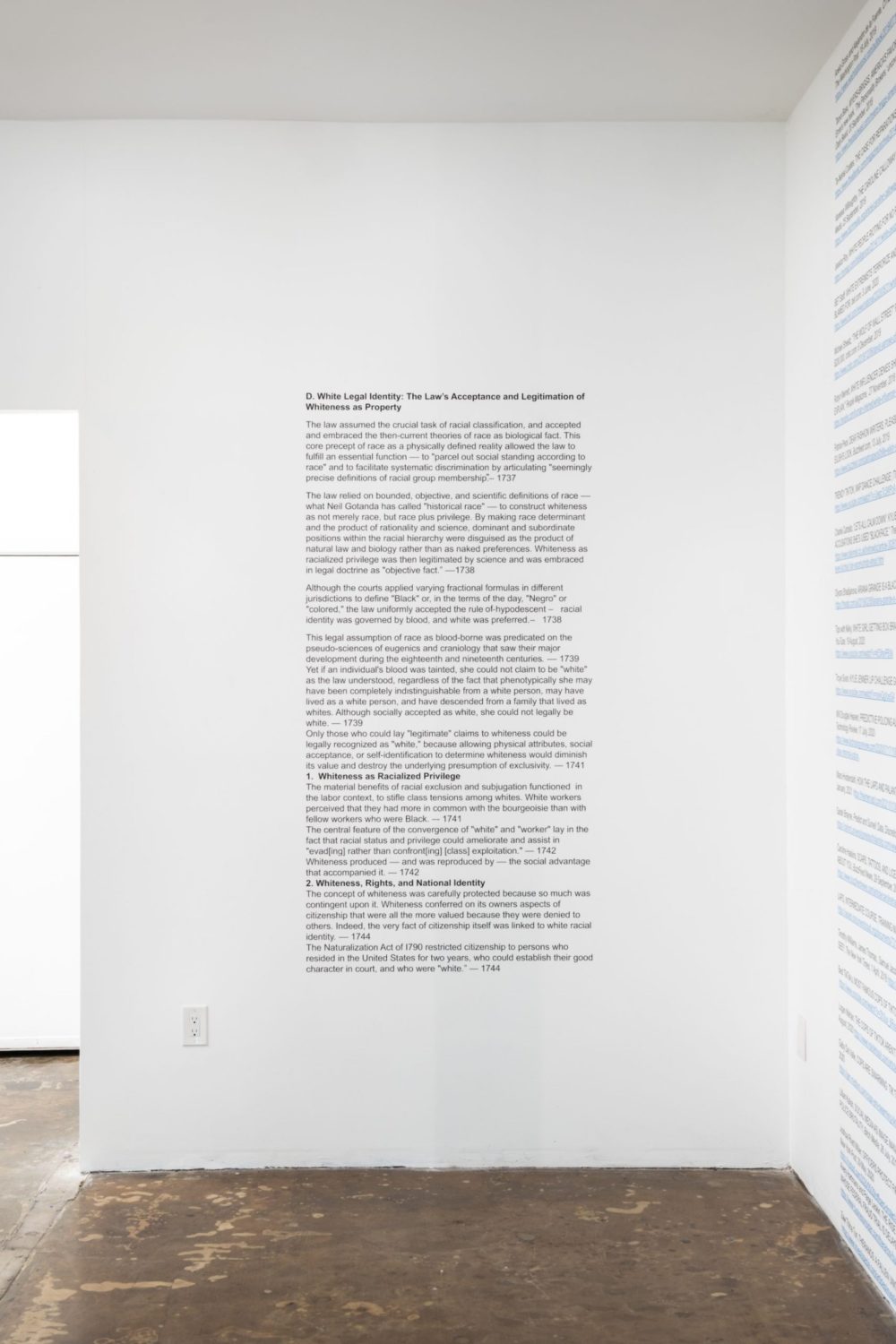
- Source: Hyperallergic
- Author: Allison Conner
- Date: July 28, 2021
- Format: Digital
Kandis Williams’s Flourishing Black Feminist Vision
Williams, who just won the Made in LA award, readdresses harms wrought by capitalism, colonialism, and anti-Black rhetoric.

Kandis Williams, The Absolute Right to Exclude: Reflections on and Implications of Cheryl Harris’ “Whiteness as Property,” LAXART (photo by Ruben Diaz)
LOS ANGELES — The Los Angeles-based artist Kandis Williams makes work that alchemizes feelings of loss and dissent. Encompassing collage, installation, performance, writing, and publishing, she investigates and deflates our social constructions and how they are experienced through the prisms of race, gender, nationalism, psychology, and eroticism. In July, the Hammer Museum announced Williams as the winner of the Mohn Award; the $100,000 prize is given every year to an artist featured in the Made in LA biennial. The jury praised Williams’s ability to synthesize past and present when critically readdressing the harms wrought by capitalism, colonialism, and anti-Black rhetoric.
In addition to her theatrical collage work in the biennial, two current exhibitions provide a thrilling peek into Williams’s cerebral and protean approach to art. Eurydice, presented by Night Gallery, is dedicated to her performance and video work. Between 2018 and 2020, Williams staged five performances in Los Angeles, Berlin, Montreal, and St. Louis, all part of a project that reworked the Greek myth of Eurydice into a meditation on racialized spectatorship and its effect on conceptions of Black subjectivity. Eurydice (2021) splices the performance footage into a 21-minute video that unfolds across a huge, two-channel installation arranged in a V-shape. Dancer Josh Johnson plays a hybrid Orpheus/Eurydice role. In one sequence, he marches away from the unsteady, soft-focused camera on the left screen, while the right screen shows the same incident from a wide angle, allowing you to see not only the cameraperson recording Johnson, but also the scores of people proceeding behind them in their wake. The bifurcated view comments on the parasitic relationship mainstream culture has to Black culture and people, and the psychic effect of such scrutiny.

Kandis Williams: Eurydice at Night Gallery (image courtesy the artist and Night Gallery, Los Angeles, photo by Marten Elder)
The Absolute Right to Exclude: Reflections on and Implications of Cheryl Harris’ “Whiteness as Property,” presented by LAXART, highlights Cassandra Press, the multifaceted publishing platform and educational resource founded by Williams in 2016. Disturbed by the rise of right-wing authoritarianism and emboldened by the political activism reawakened by Black Lives Matter, Williams began the press to circulate non-Western canons and aesthetic philosophies. Known for offering lo-fi readers that compile critical writing and scholarship by Black thinkers on misogynoir, fetishism, cultural cannibalism, Black Twitter, and other topics, Cassandra Press circumvents the usual access barriers built into academia in favor of a pedagogical style rooted in feminist Black theory.
For the LAXART show, Williams transforms the gallery into an immersive reader, filling the white walls with excerpts from “Whiteness as Property,” the influential 1993 essay by legal theorist Cheryl Harris (who is also the mother of rapper Earl Sweatshirt). Harris’s essay traces the ways in which “the origins of property rights are rooted in racial domination,” or in other words, how whiteness went from a constructed racial identity to a form of property recognized and protected by the law. This codification allows for the reproduction of white supremacist systems in the present.

Kandis Williams, The Absolute Right to Exclude: Reflections on and Implications of Cheryl Harris’ “Whiteness as Property,” LAXART
(photo by Ruben Diaz)
In the center of the gallery is a freestanding wall overrun with hundreds of images taken from online sources, as if Williams transformed the screenshot grid of a phone into an architectural form. Images of white Instagram influencers sporting Blackface are mixed with stills swiped from Keeping Up With The Kardashians, footage from the January 6 Capitol Hill attack, and other ephemera from literature, film, and cultural archives. Gazing upon the wall feels like traversing an endless doomscroll, one that reflects our chaotic racial history and how this lineage of exclusion continues to articulate itself in mainstream American culture.
From classical art to social media, Williams incisively deconstructs how culture has been weaponized as an extension of oppressive power. In both shows, her experimental pedagogies offer paths of dissent rooted in Black radical expression and thought.
The Absolute Right to Exclude: Reflections on and Implications of Cheryl Harris’ “Whiteness as Property” continues at LAXART (California Route 2, 7000 Santa Monica Boulevard, West Hollywood) through July 31. Eurydice continues at Night Gallery (2276 East 16th St, Downtown, Los Angeles) through August 7.

